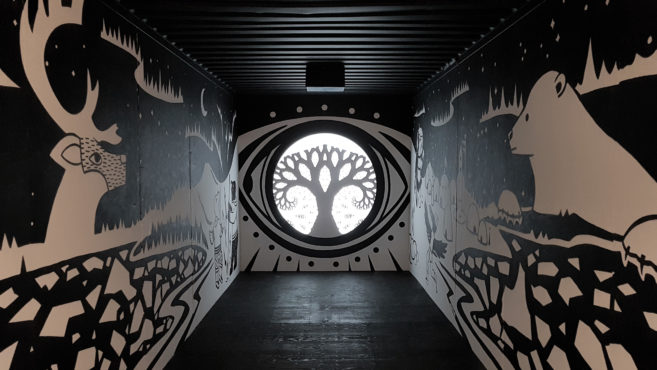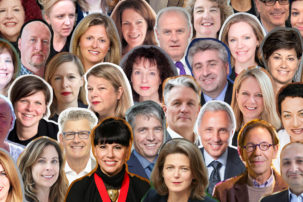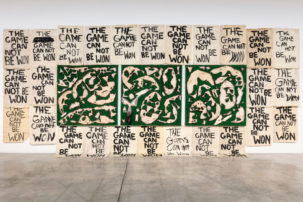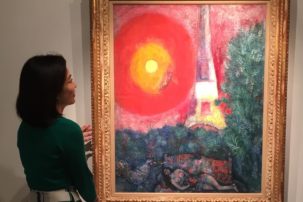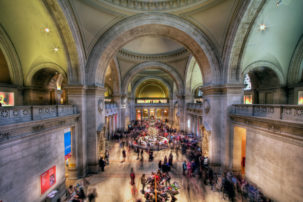“Things are about to get bad in ways that we will and will not see.”
This is what award-winning American poet and MacArthur “Genius” Grant recipient Claudia Rankine told her Yale University students on the day after the 2016 US Election.
And this is also what Claudia Rankine relayed, via anecdote, during a recent lecture at the Banff Centre.
In Rankine’s July 26 public talk—part of a small, unique residency program called “Banff Research in Culture: Year 2067”—the founder of the Racial Imaginary Institute masterfully led the audience through a series of images and narratives exploring whiteness in both popular and fine-art culture.
Given the white supremacist violence in Charlottesville on August 11 and 12— just a few weeks after her talk—the research Rankine presented in Banff has become even more vital and necessary.
From reflecting on Louis CK’s stand-up routine about how he loves being white (at least in the present) to noting how the photography of Ansel Adams and Carleton Watkins have played into notions of “white greatness and white ownership of the country,” Rankine’s public talk in Banff covered a wide, white ground, revealing white supremacy, white fragility and anti-Black racism in sites where it is often undetected or overlooked—at least by those who have enough white privilege to do so.
Her message: It’s beyond time to look more closely at whiteness both within and beyond art, curation and other cultural spheres. Of course, this isn’t just a US issue—there are plenty of implications and takeaways for Canadian art institutions to consider, here, too.
Studying the White Orientation of the Trump Era
Rankine started her talk on a note that was both personal and political; she talked about, in her words, the “depression” that many of her friends, acquaintances and colleagues seemed to fall into following the November 2016 US election.
Rankine attributed this phenomenon—exemplified by symptoms such as crying in public, or staying in bed for days—to the fact that Americans were finally confronted by “a recognition of who and what we also were.”
That recognition of the white supremacy tied up with America was laid bare in the fact that Trump had “an overt white nationalist orientation,” noted Rankine—and yet was still elected.
“Trump’s rise to power had to do with wilful ignorance of white supremacy,” Rankine elucidated.
“The fiction of this election [was] that the people who voted from Trump were white, poor, uneducated,” Rankine said. There were actually many with college degrees.
Archival photographs were also part of Rankine’s public lecture, including a photograph of a KKK march on Washington in 1924.
Looking at that photograph, with hundreds of white hoods arrayed before the white dome of the Capitol, Rankine stated, “Nothing that is happening now has not already happened.”
Advice and Observations for Museums, Curators and Teachers Today
During the question and answer session following the lecture, Rankine was asked for pedagogical advice on how to deal a classroom debate about whether a white curator could curate a show of Black artists.
In the first part of her response, Rankine spoke about freedom and safety.
“What was nice about the [Yale] class for me was it was the one place where all discussions were allowed,” Rankine said. “It is disturbing to me that one would want to replicate the same kinds of prohibitions.”
And in the second part of her answer, Rankine pointed out that many concerns around white curators and art-gallery leaders are being expressed for good historical reasons.
“The reason people are mobilizing is because they have been disappointed again and again,” Rankine said. “We saw this at the Walker with the [Sam Durant] sculpture…. No one thought to ask anyone in the Indigenous communities.”
Claudia Rankine and the Racial Imaginary Institute, which she started with her McArthur “Genius” Grant, ran an event called “Perspectives on Race and Representation” at the Whitney in April—an event sparked by controversy over Dana Schutz’s painting of Emmett Till in the Whitney Biennial.
While Rankine wanted to do the event, she noted that it was not until after that event that she heard of Whitney higher-ups actually starting to initiate conversations on bias within the institution itself.
“They never had thought before about how race functioned within the Whitney,” said Rankine.
Possible Questions and Takeaways for Canadian Art Institutions
What would it mean to apply some of the material Rankine discussed in Banff to an analysis of Canadian art institutions? How does whiteness function in Canada’s popular and fine-art images and narratives? And how are Canada’s museums and galleries, artists and curators, trying to correct injustices in this regard (or temper a tendency towards white supremacy)?
In recent years, there have been an increasing number of examples of Canadian art institutions that are trying to correct a white-centric narrative in their operations and programs.
The most obvious federal example at the moment is the National Gallery of Canada’s recent project of combining objects from its historical Canadian art collections and its historical Indigenous art collections into a single set of spaces that it calls its “Canadian and Indigenous Galleries.” (Previously, these historical NGC collections were displayed in separate spaces.)
“It coincides with the 150th anniversary of Confederation, but it really announces our way forward here at the National Gallery, in how we’re going to be telling the story of Canadian art,” gallery director and chief executive Marc Mayer told the Ottawa Citizen when the galleries were opened in June. “The story of Canadian art will always include indigenous art—they’re inseparable in my mind.”
Elsewhere, the Art Gallery of Ontario has hired two new curators in recent months. Assistant curator of photography Julie Crooks, who is black, and assistant curator of Canadian and Indigenous art Wanda Nanibush, who is Anishinaabe-kwe, are currently the only non-white people on the curatorial team. On a contract basis, two other curators (Anique Jordan, who is black, and Quill Christie-Peters, who is Anishinaabe-kwe) are a part of the curatorial team for “Every. Now. Then. Reframing Nationhood.”—a current exhibition that itself centres BIPOC artists in a reframing of what Canada has been, is and might become.
And in another example, the Winnipeg Art Gallery, earlier this year, announced Julie Nagam and Heather Igloliorte as co-chairs of the new Indigenous Advisory Circle. The formation of the circle is an important move by the gallery as it works towards the construction of a four-storey, 40,000-square-foot Inuit Art Centre in coming years.
These are just a few of the many efforts that have been ongoing in art galleries and museums of various sizes in Canada to correct against white supremacy in the cultural sphere.
Yet still, many questions remain. Why, for instance, did the NGC call its new spaces “Canadian and Indigenous Galleries” rather than “Indigenous and Canadian Galleries”? When does hiring BIPOC curators or showing BIPOC artists veer into a kind of performing for white audiences? (As curator and critic Amy Fung recently blogged of “Every. Now. Then.,” “It’s “nice” that the museum is trying to be more inclusive, but I am going to need more… it feels like the show is for white people.”) What does it mean to build a centre for Inuit art that most Inuit people will never actually get to visit, because it is so far from their home territories?
While the choices to be made next are far from clear, one more moment from Rankine’s talk comes to mind here—a moment specifically addressing white supremacy for white audiences.
“I don’t need your help,” Rankine said, quoting Fred Moten. “I just need you to recognize that this shit is killing you, too.”

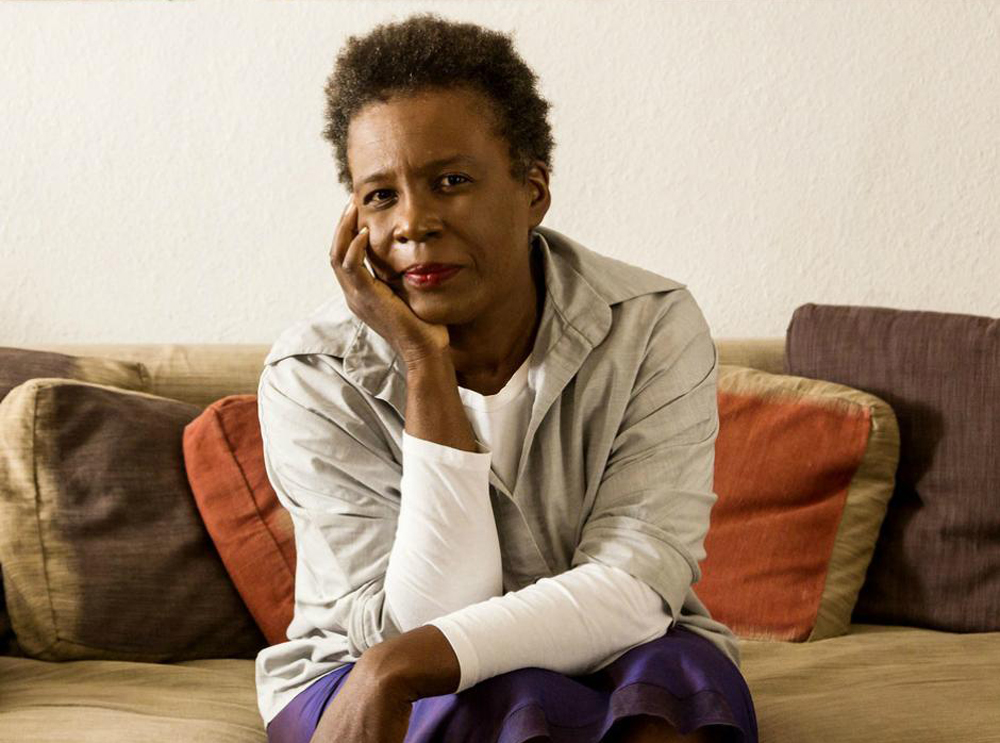 Claudia Rankine.
Claudia Rankine.
